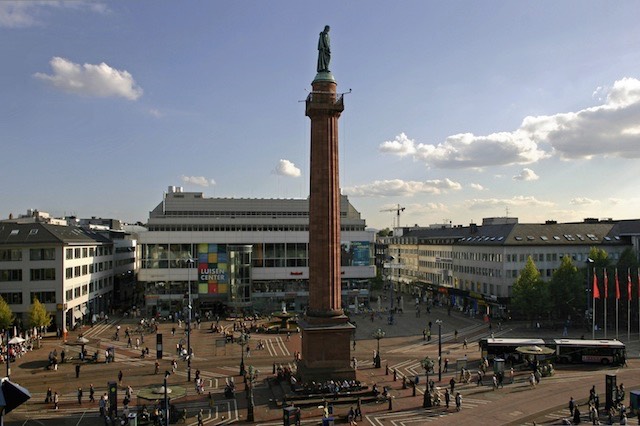The Luisenplatz is the central place in Darmstadt: here, the public transport trams and busses meet, and many people are busily crossing the place in search or shopping, having a coffee, beer, ice cream or pretzel in one of the small cafes, or simply "getting from here to there". The center of the place is taken up by the "Lange Lui" (long Louis or long Ludwig), a monument that shows Grand Duke Louis I (Ludwig I) of Hesse and by Rhine (1753-1830, ruled as a landgrave of Hesse-Darmstadt from 1790-1806 and as a Grand Duke of Hesse and by Rhine from 1806-1830). This monument is built from sandstone and was erected in 1844, 14 years after Louis I.'s death, as a way of thanking him for setting up the constitution of the the Grand Dukedom. Louis is shown in the style of a Roman senator with the constitution bill in his hand. (Note that the name Luisenplatz actually refers to a female name; the locals have a liking to mixing things that do not quite match, or giving somewhat disrespectful nicknames.)

Picture © Alex Deppert (details in the imprint)
On rare occasions, the monument is open and one can climb (for a small fee) the 172 steps of the 28 meter high monument (33 meters including the statue) to look over the city. The grand duke faces West, looking towards his old ally Napoleon in Paris.
In a corner of the Luisenplatz, close the Sparkasse (bank) building, a small statue shows Justus von Liebig (1803-1873), installed in 1913. Justus von Liebig was born in Darmstadt and was made a profeesor of chemistry at he University of Gießen (German) at age 21, where he established the world's first major school of chemistry. He made many inroads in Chemistry, such as the discovery of nitrogen, the Law of the Minimum, and the "Liebig condenser", as well as works on fertilizers. For details, please see the above Wikipedia article. He was granted the title of baron (1845) and made a fellow of the Royal Swedish Academy of Sciences in 1837 - at age 34.
The Luisenplatz also houses the Luisencenter shopping center, which is probably small from a US perspective, but is reached well by pedestrians as well as those using the below-ground parking area, visible behind the statue. Opposite the Luisencenter, the Kollegiengebäude is used by the regional council, and was built in 1777-1781. It is the only building at the Luisenplatz that was not completely destroyed in the bombing on September 11, 1944, and could thus be rebuilt according to its original design between 1949 and 1954.